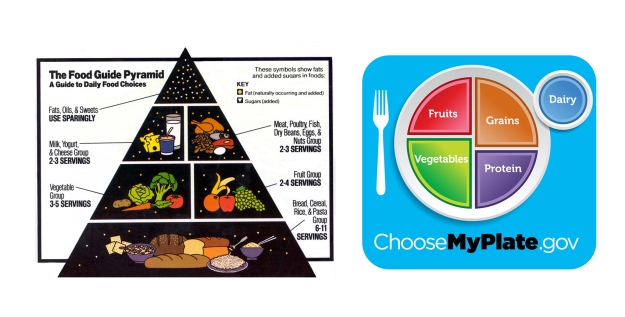For nearly 20 years, Americans relied on the food pyramid to determine the portion sizes they should eat every day. The vague categories misled people, encouraging them to eat large portions of foods that weren’t always best for their health.
Americans are eating healthier now that the food pyramid was replaced with MyPlate in 2011. New guidelines – represented by easy-to-understand visuals – make nutritional requirements simpler to understand. The 5 food groups are now represented in percentages of a plate and a glass.
But since many people think the old food pyramid still offers sound nutritional advice, our ongoing series compares myths of the old food pyramid with the new USDA guidelines of MyPlate.
This second week, we’ll highlight the MyPlate fruit and vegetable recommendations, which combined should cover half the plate.
Fruits
Food Pyramid
The old food pyramid suggested 2-4 servings of fruits, which was too general. Guidelines didn’t explain if a serving meant a whole apple or 5 grapes? It also didn’t offer specific suggestions for adults or children, or break it down to the requirements for males and females of all ages.
MyPlate – Brightly colored like a slice of juicy watermelon and representing 20% of the plate, this new visual standard for fruit is easier to understand. Further explanation points out how many cups of fruit are recommended – ranging from children 3 and younger needing only 1 cup to an adult male needing 2 cups per day. This is based on people who exercise less than 30 minutes per day and allows the very active to have more.
Even though the approximate size of a cup is easy to visualize, it’s not always practical that fruit will be cut up first. Here are some standard fruit servings based on 1 cup:
- 1 orange
- 8 strawberries
- 1 wedge of watermelon
- 32 grapes
- 1 banana
Remember – Although packed with vitamins and nutrients, dried fruits are higher in calories and amounts should be reduced by half.
Vegetables
Food Pyramid – Just like fruits, the amount of vegetables needed per day was recommended by servings – 3-5 servings – with the same concerns of what was meant by a serving – 1 carrot, 1 cucumber or a bowl of salad?
MyPlate
With MyPlate, vegetables should represent 30% of a plate and the serving sizes are also in cups. The quantity is also broken down and recommended by age and sex, just like fruit.
As an added benefit, vegetables are further categorized in 5 groups with recommended amounts for the entire week, such as ½ cup of leafy green vegetables for children 2-3 years old and 5 cups of starchy vegetables for women age 31-50:
- Dark green
- Starchy
- Red and orange
- Beans and peas
- All others
Just as with fruit, it’s not always easy to comprehend what a cup of vegetables is. Here are 5 vegetable recommendations based on 1 cup:
- 12 baby carrots
- 1 sweet potato
- 1 green pepper
- 1 ear of corn
- 3 stalks of broccoli
Remember – The rainbow of colorful vegetables feature a variety of antioxidants and phytochemicals – each with a unique health benefit.
For more information about MyPlate and eating the right amounts of nutritious foods, visit www.choosemyplate.gov.
Sources:
http://www.disabled-world.com/artman/publish/food_pyramid.shtml
http://www.nursingdegree.net/blog/746/10-most-pervasive-food-pyramid-myths/
Related Articles
Replacing the Food Pyramid with MyPlate

Join the Discussion
0 Comments